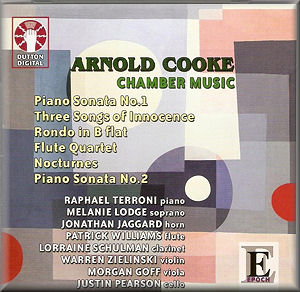 |
 |
|


alternatively
CD: Crotchet
|
Arnold COOKE
(1906-2005)
Chamber Music
Piano Sonata No.1 (1938) [18:34]
Three Songs of Innocence for soprano, clarinet and piano; (words
William Blake) (1957);
No.1 Piping down the Valleys Wild [2:06]; No.2 The Shepherd [2:15];
No.3 The Echoing Green [2:25]
Rondo in B flat for horn and piano (1950) [3:03]
Flute Quartet (1936) [18:02] ¹
Nocturnes - a cycle of five songs for voice, horn and piano (1956)
The Moon (Shelley) [2:36] Returning, We Hear the Larks (Isaac Rosenberg)
[2:19] River Roses (D H Lawrence) [2:51] The Owl (Tennyson) [1:06]
The Boat Song (John Davidson) [2:08]
Piano Sonata No.2 (1965) [17:35]
 Raphael Terroni (piano)
Raphael Terroni (piano)
Melanie Lodge (soprano)
Jonathan Jaggard (horn)
Patrick Williams (flute); Warren Zielinski (violin); Morgan Goff
(viola); Justin Pearson (cello) ¹
Lorraine Schulman (clarinet)
rec. Potton Hall, Suffolk, 15-16 July 2008; St Silas Church, London;
21 July 2008 (Flute Quartet)
 DUTTON CDLX7247 [76:32]
DUTTON CDLX7247 [76:32] 
|
|
|
It’s good to see increasing interest in Arnold Cooke’s
music. This wide-ranging disc of his chamber music gives us
a sheaf of first recordings; both piano sonatas and the Flute
Quartet are making their first appearances on disc.
The First Sonata was written in 1938 but only published in 2005,
posthumously. It’s a three movement work of sensible construction
and effective contrasts. A taut march opens the first movement
with its more relaxed ensuing B section. The writing is strong
and confident, and sounds idiomatic to play. The initial arch
of the Andante promises fluid a lyric Aria but it soon becomes
infiltrated by chromaticism, though never enough to unseat its
basic impulse. Whereas the finale is sprightly and vital though,
one feels, the fugal feint is rather misplaced as a device.
The false ending is much better. One knows that the word ‘Hindemith’
is never far away when referring to Cooke’s music, but
there are few overt signs of it here. The Second Sonata followed
nearly thirty years later. The controlled vehemence of its opening,
toccata like, is a reminder that Cooke had lost nothing of his
dramatic instinct. And whilst chromaticism flooded the song-like
impulses in the earlier sonata, in the second it’s dissonance
that attempts to subvert the writing. Here, however, the tighter
construction and more integrated writing ensure that the sonata
is that much more plausible and logically convincing. The finale
is affirmative, even joyful, though there is a fugato here as
well. As throughout, Raphael Terroni plays with eloquent control
and he manages finely to balance the extroversion of Cooke’s
writing with those moments of palpable warmth.
Written in 1936, just after his studies with Hindemith therefore,
the Flute Quartet is thoroughly charming - and rather French.
It summons up the era of Georges Barrère and the kind
of works he performed; gauzy, impressionist and evocative. It’s
remarkable quite how impressionist this work actually sounds,
and its Debussian lineage and ethos, whilst distinct, is distinctly
attractive. The gestures in the slow movement, for instance,
are very expressive, unusually so perhaps for Cooke and the
flowing variations - so seamless - and the flute’s resonant
soliloquy, are fulsome and rich. A clean-limbed Rondo finale
ends with a decisive pizzicato full stop.
There are two song cycles. The Blake cycle is Three Songs of
Innocence for soprano, clarinet and piano. Melanie Lodge is
an excellent guide, filing down her tone in the second song
whilst clarinettist Lorraine Schulman is fluently genial, especially
in the first. Nocturnes is a rather more reserved series
of settings, a cycle of five songs for voice, horn and piano
written in 1956. One feels the influence of Britten from time
to time, notably the Serenade for Tenor, Horn and Strings. Cooke
isn’t afraid to paint richly; the piano’s treble
trills evoke the larks in the Rosenberg setting whilst the horn
hints at the Reveille. There’s a scherzo-like Tennyson
setting of The Owl that works in a similar way to Britten’s
use of Ben Jonson’s Hymn in his Serenade. The final
setting, that of John Davidson’s The Boat Song,
seems to play off Britten and Hindemith.
Finally we have the Rondo for horn and piano with its jaunty
hunting motif. Its bubbly effusion is tangily realised.
There are no texts, but good notes. Cooke emerges as a vitalising
chamber composer. And how pleasing to get the piano sonatas
after so long a wait.
Jonathan Woolf
|
|

